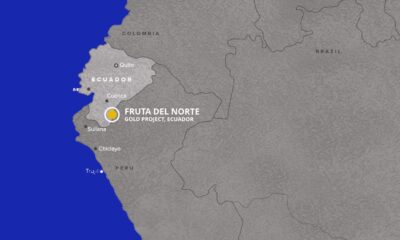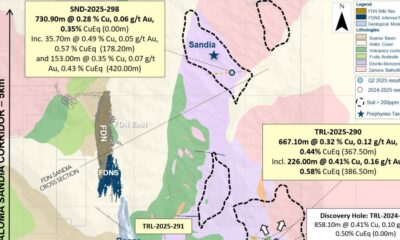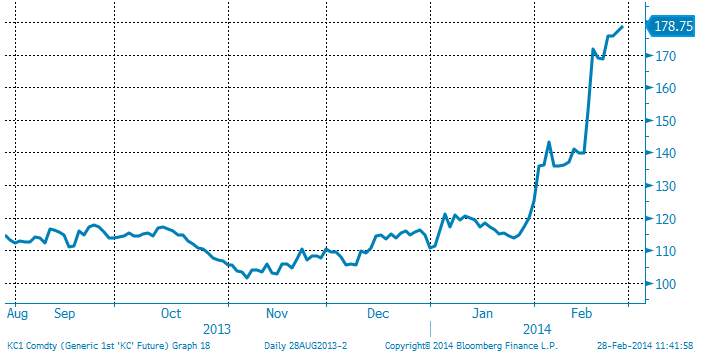Analys
SHB Råvarubrevet 28 februari 2014

![]() Veckan som gick var ovanligt tunn på makronyheter men vi laddar inför nästa veckas inköpschefsindex och payrolls. Väldigt viktig data då Kinas inköpschefer har surnat till under fyra månader i rad och USA:s dito gav en riktigt låg siffra förra månaden. Investerare som har överviktat råvaror under detta år har haft en bra utveckling. Det är det dock få som har gjort. Årets finansmarknad har tagit konsensus syn på sängen. Aktier har varit skakigt och guld med flera andra råvaror starka. För oss som väntar på ett svagare Kina var den urstarka råvaruimporten i januari en stor överraskning. En del av krafterna till årets prisuppgång för råvaror kommer dock antagligen vara tillfälliga. Väderguden ligger bakom de flesta uppgångarna. Extrem kyla i USA drev upp priset på olja och naturgas. Torkan i Brasilien priset på kaffe och socker. Även om vi inte tror att 2014 kommer vara ett starkt år för råvarubeta så är det viktigt att komma ihåg varför råvaror kan springa ifrån övriga finansmarknaden. Väder, geopolitik, strejker och exportförbud är alla oväntade till sin natur och drivkraften bakom råvarornas diversifierande egenskap i portföljen. I dagsläget råder också backwardation för de flesta råvaror vilket gör att kostnaden för råvaruexponering är billigare än på länge!
Veckan som gick var ovanligt tunn på makronyheter men vi laddar inför nästa veckas inköpschefsindex och payrolls. Väldigt viktig data då Kinas inköpschefer har surnat till under fyra månader i rad och USA:s dito gav en riktigt låg siffra förra månaden. Investerare som har överviktat råvaror under detta år har haft en bra utveckling. Det är det dock få som har gjort. Årets finansmarknad har tagit konsensus syn på sängen. Aktier har varit skakigt och guld med flera andra råvaror starka. För oss som väntar på ett svagare Kina var den urstarka råvaruimporten i januari en stor överraskning. En del av krafterna till årets prisuppgång för råvaror kommer dock antagligen vara tillfälliga. Väderguden ligger bakom de flesta uppgångarna. Extrem kyla i USA drev upp priset på olja och naturgas. Torkan i Brasilien priset på kaffe och socker. Även om vi inte tror att 2014 kommer vara ett starkt år för råvarubeta så är det viktigt att komma ihåg varför råvaror kan springa ifrån övriga finansmarknaden. Väder, geopolitik, strejker och exportförbud är alla oväntade till sin natur och drivkraften bakom råvarornas diversifierande egenskap i portföljen. I dagsläget råder också backwardation för de flesta råvaror vilket gör att kostnaden för råvaruexponering är billigare än på länge!
Nu kan du även handla El med fyra gångers hävstång! Fallande elpriser sedan 2010 har gjort att även volatiliteten fallit ordentligt, varför vi nu lanserar dessa tradingvänliga kontrakt.
Det milda och våta vädret består vilket gör att elen handlas på mycket låga nivåer och där det sammanfattningsvis fortsatt är ett läge med god risk / reward att vara kort. Närmsta kvartalet har backat närmare 10 procent under året och det är just nu svårt att se vad som skall vända trenden sett till det milda vädret, låga bränslepriser, välfyllda vattenmagasin och där t.o.m kärnkraften går som den skall!. Det är egentligen bara utsläppsrätterna som stigit i år till en förväntade nivån om ca 7 euro då EU Kommissionen verkar för att minska överskottet. För att ändå lyfta fram något som kan skapa intressanta rörelser är marknadens tradingpositioner. När marknaden blir väldigt kort som i detta fall tenderar det alltid öka känsligheten på uppsidan med möjlighet till god avkastning där våra långa certifikat kan bli intressanta. Marknaden har hittills satt sig ganska snabbt vid väderomslag utan några större vinsthemtagningar eftersom de bestående högtrycken uteblivit så vi är inte där riktigt ännu. Men det skadar inte att påminna om att vi fortfarande är i februari, och vinterväder har överraskat oss förr. Lite likt ekonomisk analys finns en egenhet att titta i backspegeln, och med hjälp av historien försöka förutspå framtiden, även när det gäller väder. 2013 – ett oerhört starkt år på börsen – har fått nästan alla att tro på stigande aktiepriser 2014. En mild vinter i hela Sverige verkar ha fått oss alla att tro att det är över för denna gången. Men för den som sysslar med vädermässiga – och ekonomiska – realiteter är det givet att en het sommar utan regn inte får oss att tro att det aldrig mer kommer att regna igen. Även om det kan kännas så. Vi erbjuder nu 6 certifikat på el; LONG EL H & SHRT EL H är våra raka certifikat utan hävstång, BULL EL H & BEAR EL H är våra certifikat med dubbel hävstång samt BULL EL X4 H & BEAR EL X4 är certifikat för dig som vill handla el med hög hävstång. Kom ihåg att fyra gångers hävstång innebär att du inte ska låta dessa kontrakt ”ligga i lådan”, utan snabbt in – snabbt ut. Annars kan det kosta avkastning.
Kaffepriset har nu stigit 60 procent sedan årsskiftet!
Torkan i sydöstra (Minas Gerais) Brasilien fortsätter och situationen förvärras allt mer. Efter en torr januari månad lämnar vi även februari månad bakom oss utan regn i de viktiga kafferegionerna. I dagsläget finns det heller inga prognoser som talar för mer regn under de kommande veckorna. Även exporten från Vietnam (Robusta) har varit en besvikelse. Den stora frågan är nu hur stor del av årets produktion som är drabbad? Vi tror att terminspriserna på kaffe kan stiga ytterligare något fram till efter regnperiodens slut (april) och tills dess att estimerade produktionssiffror når marknaden. Om torkan blir långvarig och produktionsbortfallet för innevarande kaffeår blir stort, kan viss del kompenseras av de lager som byggts upp under senaste årens överproduktion.
[box]SHB Råvarubrevet är producerat av Handelsbanken och publiceras i samarbete och med tillstånd på Råvarumarknaden.se[/box]
Ansvarsbegränsning
Detta material är producerat av Svenska Handelsbanken AB (publ) i fortsättningen kallad Handelsbanken. De som arbetar med innehållet är inte analytiker och materialet är inte oberoende investeringsanalys. Innehållet är uteslutande avsett för kunder i Sverige. Syftet är att ge en allmän information till Handelsbankens kunder och utgör inte ett personligt investeringsråd eller en personlig rekommendation. Informationen ska inte ensamt utgöra underlag för investeringsbeslut. Kunder bör inhämta råd från sina rådgivare och basera sina investeringsbeslut utifrån egen erfarenhet.
Informationen i materialet kan ändras och också avvika från de åsikter som uttrycks i oberoende investeringsanalyser från Handelsbanken. Informationen grundar sig på allmänt tillgänglig information och är hämtad från källor som bedöms som tillförlitliga, men riktigheten kan inte garanteras och informationen kan vara ofullständig eller nedkortad. Ingen del av förslaget får reproduceras eller distribueras till någon annan person utan att Handelsbanken dessförinnan lämnat sitt skriftliga medgivande. Handelsbanken ansvarar inte för att materialet används på ett sätt som strider mot förbudet mot vidarebefordran eller offentliggörs i strid med bankens regler.
Analys
Brent edges higher as India–Russia oil trade draws U.S. ire and Powell takes the stage at Jackson Hole

Best price since early August. Brent crude gained 1.2% yesterday to settle at USD 67.67/b, the highest close since early August and the second day of gains. Prices traded to an intraday low of USD 66.74/b before closing up on the day. This morning Brent is ticking slightly higher at USD 67.76/b as the market steadies ahead of Fed Chair Jerome Powell’s Jackson Hole speech later today.

No Russia/Ukraine peace in sight and India getting heat from US over imports of Russian oil. Yesterday’s price action was driven by renewed geopolitical tension and steady underlying demand. Stalled ceasefire talks between Russia and Ukraine helped maintain a modest risk premium, while the spotlight turned to India’s continued imports of Russian crude. Trump sharply criticized New Delhi’s purchases, threatening higher tariffs and possible sanctions. His administration has already announced tariff hikes on Indian goods from 25% to 50% later this month. India has pushed back, defending its right to diversify crude sourcing and highlighting that it also buys oil from the U.S. Moscow meanwhile reaffirmed its commitment to supply India, deepening the impression that global energy flows are becoming increasingly politicized.
Holding steady this morning awaiting Powell’s address at Jackson Hall. This morning the main market focus is Powell’s address at Jackson Hole. It is set to be the key event for markets today, with traders parsing every word for signals on the Fed’s policy path. A September rate cut is still the base case but the odds have slipped from almost certainty earlier this month to around three-quarters. Sticky inflation data have tempered expectations, raising the stakes for Powell to strike the right balance between growth concerns and inflation risks. His tone will shape global risk sentiment into the weekend and will be closely watched for implications on the oil demand outlook.
For now, oil is holding steady with geopolitical frictions lending support and macro uncertainty keeping gains in check.
Oil market is starting to think and worry about next OPEC+ meeting on 7 September. While still a good two weeks to go, the next OPEC+ meeting on 7 September will be crucial for the oil market. After approving hefty production hikes in August and September, the question is now whether the group will also unwind the remaining 1.65 million bpd of voluntary cuts. Thereby completing the full phase-out of voluntary reductions well ahead of schedule. The decision will test OPEC+’s balancing act between volume-driven influence and price stability. The gathering on 7 September may give the clearest signal yet of whether the group will pause, pivot, or press ahead.
Analys
Brent sideways on sanctions and peace talks

Brent crude is currently trading around USD 66.2 per barrel, following a relatively tight session on Monday, where prices ranged between USD 65.3 and USD 66.8. While expectations of higher OPEC+ supply continue to weigh on sentiment, recent headlines have been dominated by geopolitics – particularly developments in Washington.

At the center is the White House meeting between Trump, Zelenskyy, and several key European leaders. During the meeting, Trump reportedly placed a direct call to Putin to discuss a potential bilateral sit-down between Putin and Zelenskyy, which several European officials have said could take place within two weeks.
While the Kremlin’s response remains vague, markets have interpreted this as a modestly positive signal, with both equities and global oil prices holding steady. Brent is marginally lower since yesterday’s close, while U.S. and Asian equity markets remain broadly flat.
Still, the political undertone is shifting, and markets may be underestimating the longer-term implications. According to the NY times, Putin has proposed a peace plan under which Russia would claim full control of the Donbas in exchange for dropping demands over Kherson and Zaporizhzhia – territories it has not yet seized.
Meanwhile, discussions around Ukraine’s long-term security framework are starting to take shape. Zelenskyy appeared encouraged by Trump’s openness to supporting a post-war security guarantee for Ukraine. While the exact terms remain unclear, U.S. special envoy Steve Witkoff stated that Putin had signaled willingness to allow Washington and its allies to offer Kyiv a NATO-style collective defense guarantee – a move that would significantly reshape the regional security landscape.
As diplomatic efforts gain momentum, markets are also beginning to assess the potential consequences of a partial or full rollback of U.S. sanctions on Russian energy. Any unwind would likely be gradual and uneven, especially if European allies resist or delay alignment. The U.S. could act unilaterally by loosening financial restrictions, granting Russian firms greater access to Western capital and services, and effectively neutralizing the price cap mechanism. However, the EU embargo on Russian crude and products remains a more immediate constraint on flows – particularly as it continues to tighten.
Even if the U.S. were to ease restrictions, Moscow would remain heavily reliant on buyers like India and China to absorb the majority of its crude exports, as European countries are unlikely to quickly re-engage in energy trade. That shift is already playing out. As India pulls back amid newly doubled U.S. tariffs – a response to its ongoing Russian oil purchases – Chinese refiners have stepped in.
So far in August, Chinese imports of Russia’s Urals crude – typically shipped from Baltic and Black Sea ports – have nearly doubled from the YTD average, with at least two tankers idling off Zhoushan and more reportedly en route (Kpler data). The uptick is driven by attractive pricing and the absence of direct U.S. trade penalties on China, which remains in a delicate tariff truce with Washington.
Indian refiners, by contrast, are notably more cautious – receiving offers but accepting few. The takeaway is clear: China is acting as the buyer of last resort for surplus Russian barrels, likely directing them into strategic storage. While this may temporarily cushion the effects of sanctions relief, it cannot fully offset the constraints imposed by Europe’s ongoing absence.
As a result, any meaningful boost to global supply from a rollback of U.S. sanctions on Russia may take longer to materialize than headlines suggest.
Analys
Crude inventories builds, diesel remain low

U.S. commercial crude inventories posted a 3-million-barrel build last week, according to the DOE, bringing total stocks to 426.7 million barrels – now 6% below the five-year seasonal average. The official figure came in above Tuesday’s API estimate of a 1.5-million-barrel increase.

Gasoline inventories fell by 0.8 million barrels, bringing levels roughly in line with the five-year norm. The composition was mixed, with finished gasoline stocks rising, while blending components declined.
Diesel inventories rose by 0.7 million barrels, broadly in line with the API’s earlier reading of a 0.3-million-barrel increase. Despite the weekly build, distillate stocks remain 15% below the five-year average, highlighting continued tightness in diesel supply.
Total commercial petroleum inventories (crude and products combined, excluding SPR) rose by 7.5 million barrels on the week, bringing total stocks to 1,267 million barrels. While inventories are improving, they remain below historical norms – especially in distillates, where the market remains structurally tight.
-

 Nyheter3 veckor sedan
Nyheter3 veckor sedanKopparpriset i fritt fall i USA efter att tullregler presenterats
-

 Nyheter3 veckor sedan
Nyheter3 veckor sedanLundin Gold rapporterar enastående borrresultat vid Fruta del Norte
-

 Nyheter3 veckor sedan
Nyheter3 veckor sedanStargate Norway, AI-datacenter på upp till 520 MW etableras i Narvik
-

 Nyheter4 veckor sedan
Nyheter4 veckor sedanMängden M1-pengar ökar kraftigt
-

 Nyheter3 veckor sedan
Nyheter3 veckor sedanLundin Gold hittar ny koppar-guld-fyndighet vid Fruta del Norte-gruvan
-

 Nyheter2 veckor sedan
Nyheter2 veckor sedanGuld stiger till över 3500 USD på osäkerhet i världen
-

 Nyheter2 veckor sedan
Nyheter2 veckor sedanOmgående mångmiljardfiasko för Equinors satsning på Ørsted och vindkraft
-

 Nyheter3 veckor sedan
Nyheter3 veckor sedanAlkane Resources och Mandalay Resources har gått samman, aktör inom guld och antimon






